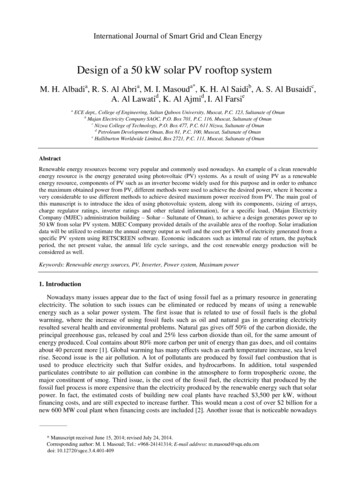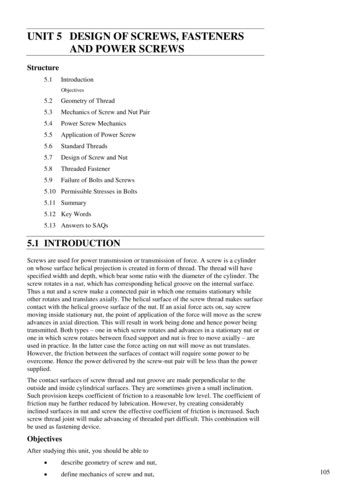
Transcription
International Journal of Smart Grid and Clean EnergyDesign of a 50 kW solar PV rooftop systemM. H. Albadia, R. S. Al Abria, M. I. Masouda*, K. H. Al Saidib, A. S. Al Busaidic,A. Al Lawatid, K. Al Ajmid, I. Al FarsieaECE dept., College of Engineering, Sultan Qaboos University, Muscat, P.C. 123, Sultanate of OmanbMajan Electricity Company SAOC, P.O. Box 701, P.C. 116, Muscat, Sultanate of OmancNizwa College of Technology, P.O. Box 477, P.C. 611 Nizwa, Sultanate of OmandPetroleum Development Oman, Box 81, P.C. 100, Muscat, Sultanate of OmaneHalliburton Worldwide Limited, Box 2721, P.C. 111, Muscat, Sultanate of OmanAbstractRenewable energy resources become very popular and commonly used nowadays. An example of a clean renewableenergy resource is the energy generated using photovoltaic (PV) systems. As a result of using PV as a renewableenergy resource, components of PV such as an inverter become widely used for this purpose and in order to enhancethe maximum obtained power from PV, different methods were used to achieve the desired power, where it become avery considerable to use different methods to achieve desired maximum power received from PV. The main goal ofthis manuscript is to introduce the idea of using photovoltaic system, along with its components, (sizing of arrays,charge regulator ratings, inverter ratings and other related information), for a specific load, (Majan ElectricityCompany (MJEC) administration building – Sohar – Sultanate of Oman), to achieve a design generates power up to50 kW from solar PV system. MJEC Company provided details of the available area of the rooftop. Solar irradiationdata will be utilized to estimate the annual energy output as well and the cost per kWh of electricity generated from aspecific PV system using RETSCREEN software. Economic indicators such as internal rate of return, the paybackperiod, the net present value, the annual life cycle savings, and the cost renewable energy production will beconsidered as well.Keywords: Renewable energy sources, PV, Inverter, Power system, Maximum power1. IntroductionNowadays many issues appear due to the fact of using fossil fuel as a primary resource in generatingelectricity. The solution to such issues can be eliminated or reduced by means of using a renewableenergy such as a solar power system. The first issue that is related to use of fossil fuels is the globalwarming, where the increase of using fossil fuels such as oil and natural gas in generating electricityresulted several health and environmental problems. Natural gas gives off 50% of the carbon dioxide, theprincipal greenhouse gas, released by coal and 25% less carbon dioxide than oil, for the same amount ofenergy produced. Coal contains about 80% more carbon per unit of energy than gas does, and oil containsabout 40 percent more [1]. Global warming has many effects such as earth temperature increase, sea levelrise. Second issue is the air pollution. A lot of pollutants are produced by fossil fuel combustion that isused to produce electricity such that Sulfur oxides, and hydrocarbons. In addition, total suspendedparticulates contribute to air pollution can combine in the atmosphere to form tropospheric ozone, themajor constituent of smog. Third issue, is the cost of the fossil fuel, the electricity that produced by thefossil fuel process is more expensive than the electricity produced by the renewable energy such that solarpower. In fact, the estimated costs of building new coal plants have reached 3,500 per kW, withoutfinancing costs, and are still expected to increase further. This would mean a cost of over 2 billion for anew 600 MW coal plant when financing costs are included [2]. Another issue that is noticeable nowadays* Manuscript received June 15, 2014; revised July 24, 2014.Corresponding author: M. I. Masoud; Tel.: 968-24141314; E-mail address: m.masoud@squ.edu.omdoi: 10.12720/sgce.3.4.401-409
402International Journal of Smart Grid and Clean Energy, vol. 3, no. 4, October 2014is the water and land pollution. Water spills causes harm to plants and animals life. Coal mining alsocontributes to water pollution. Coal contains pyrite that is a Sulfur compound [3]. On the other hand,Photovoltaic offers consumers the ability to generate electricity in a clean, quiet and reliable way [4]. Toincrease the PV utility, dozens of individual PV cells are interconnected together in a sealed,weatherproof package called a module. Modules are connected either in series or parallel. The flexibilityof the modular PV system allows designers to create solar power systems that can meet a wide variety ofelectrical needs [4]. There are two broad categories of PV system: Grid-tied systems which are connectedto the public electricity grid and stand-alone systems which are isolated system [5]. The grid-tied PVconnected to the power grid at all times and do not require battery storage. A solar PV system can providepower to a home or business, reducing the amount of power required from the utility; when the solar PVsystem power generation exceeds the power needs, then the surplus power automatically will be pumpedback into the grid. A solar PV system will not operate during a power outage unless it has battery backup[8]. Standalone systems are totally self-sufficient with no connection to the utility grid system. Theygenerate electricity during daylight hours, and store excess for night time use [9].In this paper, a design up to 50 kW solar PV system to the rooftop of a head office of MJEC company– Sohar – Sultanate of Oman is introduced where necessary components between the PV system and theload for the required design are identified. The expected cost, engineering standards and realistic constraints ofthe required design are studied by using RETSCREEN software for energy and cost model2. Components of PV SystemThe PV system consists from main part which is PV cells which produces the power but there are othercomponents are also needed to, control, convert and store the energy such as PV modules, batteries,charge controllers, and inverters. The PV system and its components are detailed in the block diagramshown in Fig. 1.PV solarPanelSignalConditionningDC-DC ConverterBattery andbattery chargerDC BusGridLoadFig. 1. General block diagram of PV system2.1. PV modulesThe PV modules are a group of many cells connected either in series to increase the voltage or inparallel to increase the current. The number of cells in the model is governed by the voltage of the module.The nominal operating voltage of the system usually has to match to nominal voltage of the storagesystem [10]. PV modules are categorized as either crystalline or thin film, and they are judged on twobasic factors: efficiency and economics [10]. Crystalline modules are categorized into two main types:mono crystalline and polycrystalline. Mono crystalline modules are made from a large crystal of silicon.They are the most efficient type in converting sunlight into electricity with an efficiency reaches 18 %[11]. Also, this type is more expensive than polycrystalline. Polycrystalline modules are the mostcommon type of the PV modules and they are less efficient than the mono crystalline modules and lessexpensive. The efficiency of polycrystalline modules are rated from 13 % to 15 % [11].2.2. Batteries and charge controllersThe batteries are used to store electric energy and to be used when there is no sunlight. There are twomain types of the batteries that are used in the PV system: Lead Acid battery and Deep Cycle battery. Thebatteries in most common use are lead-acid type because of their good availability and cost effectiveness
M. H. Albadi et al.: Design of a 50 kW solar PV rooftop system403and also it is capable of producing high currents [12].A charge controller is a current-regulating device that is placed between the solar array output and thebatteries. These devices are designed to prevent the batteries from being overcharged or overly discharged[10]. Some charge controllers use on/off control using pulse width modulation. It works to slowly reducethe amount of charge that follow into the battery as the battery approach its fully charge stage [14].2.3. InvertersInverters are used to convert the battery or solar panels output to ac quantity that can be used either tobe connected to the grid or used by electric devises. There are three main types of inverters, namely;stand-alone inverters, it runs the electrical devices within the system but it cannot be connected to the grid.Grid-tie inverters, it can be connected to the grid and they are designed to automatically disconnect andshut down when there is a loss of utility supply but they do not provide backup power during poweroutages [15]. Battery backup inverters, it is a combination of the previous two types. They provide theelectricity needs by the system and they can also be connected to the grid [15].3. Maximum Power Point Tracking (MPPT)In order to improve the efficiency of solar cells and generate Maximum Power Point Tracking (MPPT)should be used. It is an electronic system that operates module of the PV in a way such that it allows themodule to produce all capable power. MPPT increases electrical efficiency of PV and helps to reducenumber of solar panels, required area for installing PV arrays for producing the desired output. Regardingthe Maximum Power Point (MPP), an experiment was conducted and the main objective was to determinethe characteristic curve of the PV module, and to be able to locate the MPP of the PV module, by meansof using PV module cells. The open circuit voltage of the PV is measured and followed by measuring thePV short circuit current. A variable resistance which resembles the load across PV panel was varied insteps, and for each corresponding value of the load, the voltage across the load and current through theload was measured. These results were used to obtain the characteristic curve of the PV module. Fig. 2shows PV characteristic curve. As the resistance of the load increases, the produced current decreases andthe output voltage across the PV panel increases. Hence, the relationship between the produced voltageand current is inversely proportional as it can be noticed in the characteristics curve of PV from Fig. 3. Itcan be noticed from Fig. 3 that there is a point in the curve where the output voltage and output currentproduces the maximum output power which represents MPP (12.1 V, 2.9 A, 35 W).Fig. 2. PV Output Voltage vs. PV Output Current Characteristics.Fig. 3: Voltage VS Power Curve According to Different Values of the Load Resistance
404International Journal of Smart Grid and Clean Energy, vol. 3, no. 4, October 20144. Proposed System DesignThe main target is to design up to 50 kW PV solar system. It is required to obtain the produced energy,the cost and financial analysis, the reduction of CO 2 emission by means of using the RETSCREENsoftware. In addition, determination of effective area that is required for the PV panels’ installation. Theoutput results and/or the product will be compared to MJEC Company given data which is listed in theappendix. RETSCREEN is an Excel-based clean energy project modeling and analysis software tool suchthat it helps the owners to determine the financial viability of potential renewable energy, energyefficiency and cogeneration projects. It is also allows to verify the ongoing energy performance [13]. TheFlowchart of RETSCREEN data obtaining process is shown in Fig. 4 (a) while constant voltage methodfor MPP algorithm to be used for the design process is shown in Fig. 4 (b).4.1. Design requirementsBefore starting with RETSCREEN modeling and analysis, it is required to select the main components:PV module type, and inverter as well as PV system mounting requirements and dimensions according toMJEC requirements. The rooftop map of MJEC company head office with dimensions is given in theappendix(a)(b)Fig. 4. Flow charts: (a) RETSCREEN software of data obtaining process and (b) constant voltage method for MPPalgorithm to be used for design process.Table 1. PV module parameters and ratings [14]Electrical characteristicsOpen Circuit Voltage (Voc)Maximum Operating Voltage (Vmp)Short Circuit Current (Isc)Maximum Operating Current (Imp)Module EfficiencyMaximum Power in STC (Pmax)Operating Temperature38.00 V30.40 V8.98 A8.22 A15.37%250 Wp-40 ºC 85 ºCTable 2. PV module specifications and dimension [14]CellNumber of cellsModule dimensionWeightFront glassFrameProtection degreePlug connector protection degreeBypass-DiodesMaximum fuse current ratingType of connectorHigh EfficiencyWarrantyGrid connectionSpecifications and dimensionsPolycrystaline Silicon solar cells 156 mm 156 mm/6 inch60 (6 10) pcs1640 mm 992 mm 50 mm / 64.6 inch 39.1 inch 2.0 inch19.6 kg3.2 mm tempered glasAnodized aluminium alloyIP65IP65/IP67 (MC4)6 pcs (IEC)/3 pcs. (UL)15 AMC4, MC4 compatible, MC3 compatible, 0-1394462-4/6-1394461-217.4 %10 years for 90 % performance and 80 % for 25 yearsON/OFF grid and easy installed
M. H. Albadi et al.: Design of a 50 kW solar PV rooftop system405A. PV module selectionThe selected PV module is BYD-250P6-30 manufactured by BYD solar company [14], where themodule parameters and ratings is included in Table 1. This module agrees with MJEC requirements [14].The maximum power of this module is found to be 250 W, hence it requires 200 module to design 50 kWPV power system. This module is able to be used for on grid utility systems [14]. More specifiedinformation is illustrated in Table 2 [14].B. Inverter selection and manufacture typeThe module name of the selected Inverter is called TRIO-27.6-TL-OUTD a three phase grid-tied typeof inverter manufactured by Aurora company [15]. Table 3 describes some of the parameters of thisinverter where it contains two independent MPPTs and the efficiency is as high as 98.2 %. In addition, themaximum dc input power for each MPPT is 16 kW, so each inverter can receive up to 32
PV solar Panel Signal Conditionning DC-DC Converter Battery and battery charger DC Bus Load Grid Fig. 1. General block diagram of PV system 2.1. PV modules The PV modules are a group of many cells connected either in series to increase the voltage or in parallel to increase the current. The number of cells in the model is governed by the voltage of the module.











